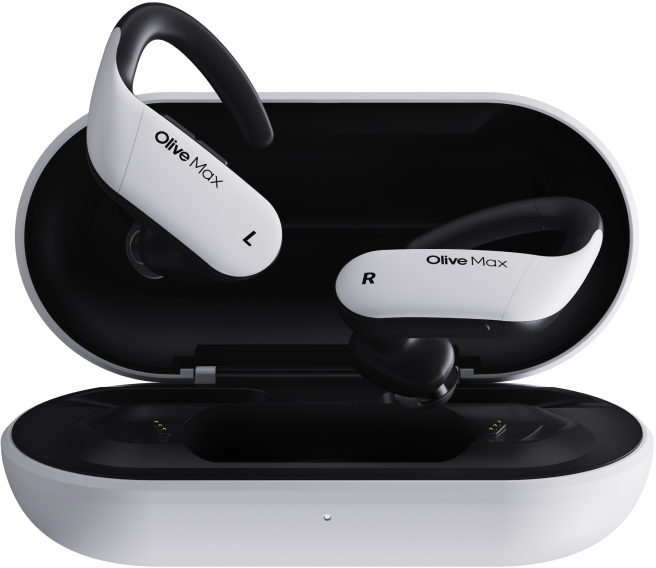
Do you wear glasses with your hearing aids?
If so, we’re sure you've grappled with the annoyance of having your hearing aids and glasses clash on the side of your head.
Whether you currently wear both or are looking at a future where you will, this article is for you.
Problems with Wearing Hearing Aids and Glasses
The compatibility of the hearing aid and glasses depends primarily on the model, shape, and size of the device.
Some of them are so small that they fit entirely in the ear, which in turn does not affect how you wear your glasses.
However, some models like the Behind-the-Ear are an external device that protrudes above the ear where the eyeglass frame should be.
With that kind of device, most people choose one of two options:
1) Having the glasses fall on top of the hearing aid
2) Having your hearing aids pass through the glasses.
There are problems with either of these options, though.
When you put your glasses on top of your hearing aids, the glasses will be substantially more prone to falling off of your face. Because the arms of the glasses are supposed to hug alongside your head, if there is not enough tension there the only force helping the glasses stay on your head is gravity.
The moment you look down or run, the glasses will most likely fall off. Neck straps are an option, but many people instead choose to pass the glasses through the hearing aid.
By passing your glasses through the hearing aid, the hearing aid will press against them and be securely intact and likely not to fall from casual movement. What you sacrifice in exchange for security, however, is comfort.
Because glasses are designed to hug the head with just the right amount of force, the added pressure from your hearing aids can impact the blood circulation behind your ears and cause headaches.
In addition, when you pass your glasses through your hearing aids, every time you move your glasses you move your hearing aids with it, causing the device to come out of place.
The Solution to Comfortably Wear Hearing Aids and Glasses
1. Picking the hearing aids that best suit your needs
Although wearing hearing aids is about mitigating the effects of hearing loss, it is also about being able to wear it every day. Feeling uncomfortable about wearing your hearing aids will most likely lead you to not wear them as often, so picking the right kind of hearing aids with the help of a specialist is very important!
Consider In-the-Ear (ITE) models that fit directly into the opening of the ear canal with nothing sitting behind the ear. With how minimal the device is, it will not obstruct your glasses or be obviously seen by people around you.
Smaller devices most of the time mean smaller battery and fewer features, so be sure to weigh in all aspects before you purchase hearing aids!
2.Tips to wearing Behind-the-Ear Models (BTE)
As we mentioned earlier in the article, wearing glasses and BTE hearing aids is a challenge. There are a few things you can do to make it easier, however!
For one, practice removing your glasses by pulling them forward with both hands instead of up with one. It’s going to take some time to make this movement a habit, but you will be less likely to knock off your hearing aid.
While the standard size will still work with many glasses and ears, you can consider a relatively new style called mini BTE. The part that fits behind the ear is a lot smaller for enhanced comfort and a less noticeable appearance. Most specialists will offer trial periods, so try all of them out before committing to one!
Finally, get used to putting your glasses first and then your hearing aids. You can maneuver your hearing aid around the arm of your glasses, which sits a little more rigidly. Look in the mirror after positioning the hearing aid so you know it looks natural and isn’t hanging off of the outer part of your ear.
3. Hearing Aid Spectacles
Still, for those who tend to remove their glasses often while workarounds exist it seems like there may be no true solution.
Enter, hearing aid spectacles.
As the name implies, spectacle hearing aids are hearing aids integrated into the frames or the arms of a pair of glasses. Spectacle hearing aids are most commonly associated with “bone conduction” (where sound is transmitted via vibrations directly to the inner ear) fittings, but some air conduction (where sound is transmitted via air conduction through the ear) spectacle hearing aids exist.
It is however worth noting that this combination device does mean that when you remove your glasses for any reason, the amplification is removed as well. Any faults with the hearing aid or lenses may mean losing out on improved hearing and vision at the same time.
Always Consult With Your Audiologist
For people who wear glasses, it might seem like your hearing aids and glasses are destined to eternally struggle. If there is anyone who can help you find the best pair of hearing aids, however, it is your audiologist. Be sure to talk to them about your lifestyle honestly so they can accurately suggest the best type of hearing aids.
The information in this guide has been written using the following reliable sources:
https://hearingexpertwirral.co.uk/guide-wearing-hearing-aid-glasses/
https://www.connecthearing.com.au/blog/hearing-aids-and-technologies/hearing-aids-glasses/
https://beltonetristate.com/hearing-aids-and-glasses/
https://www.hiddenhearing.org/hearing-aids/hearing-aid-brands/oticon-opn-s/spectacle-hearing-aids
https://www.hiddenhearing.co.uk/hearing-aids/types-of-hearing-aids/spectacle-hearing-aids









